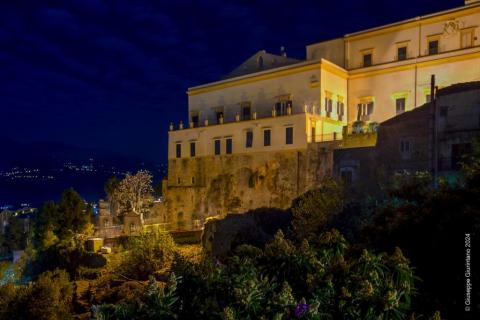The Archbishop's Palace of Monreale is a development of the Benedictine monastery, founded by King William II the Norman, who is also responsible for the construction of the famous cathedral.
Until the time of William II, the archbishops of Monreale, Benedictines and abbots of the monastery resided in the apartment reserved for them in the eastern part of the building. Later, the archbishops were no longer Benedictines, and they therefore felt the need for accommodation, extending what had been the abbots'. The first known extension dates back to the time of Giovanni Ventimiglia, who was Archbishop of Monreale from 1418 to 1449.
Palace Description
A wrought iron gate stands at the entrance with the coat of arms of Archbishop Mons. Ernesto Eugenio Filippi (1925-1951); then there is a large wooden door with the coat of arms of Archbishop Domenico Benedetto Balsamo (1816-1844) which leads to the entrance hall, while next to it there is another small one for access to the Museum with a half-length bust of the same Prelate. On the side stands the majestic Abbot's Tower, which is the oldest building.
The first salon is called Roma because of the symbols of the ancient Urbe that are frescoed on the walls, such as the bundle of rods and the Empire-style festoons. There was a statue of the Madonna holding the baby Jesus, entitled Madonna of the Chain, by the school of Gagini in the centre. It was formerly located above an altar in the cathedral, near the sacristy. Archbishop Ludovico II De Torres had it placed above the minor portico, and today it is in the Diocesan Museum. It was removed in the early 1900s and transported to the San Placido chapel until 1926, when Archbishop Monsignor Filippi had it placed in this hall on a marble pedestal.
The second hall is called the Throne Room. On the wall opposite the Chapel there was a small canopy with a picture of the Pope. Underneath there was a predella covered with a carpet and above a chair that symbolized the chair of St. Peter: a sign of the union of the local Church with the Church of Rome. Today there is a painting of the Madonna della Provvidenza. The Hall contains antique furniture and large paintings with fine prints.
The third hall, also called the Archbishops' Art Gallery, bears the coat of arms of King William II, builder of the Cathedral and Abbey, on the floor. High up around the walls are portraits of all the Archbishops of Monreale, as well as gold-embroidered altar frontals from the cathedral. The three salons are lit by four white glass chandeliers. This hall leads to the Salone Verde, where the four corners are painted with the coats of arms of the four oldest municipalities that made up the Archdiocese: for Monreale, the eight-pointed star; for Bisacquino, a marble fountain; for Corleone, a rampant lion; and, for Piana degli Albanesi, two eagles. At the centre of the ceiling, the Church is depicted holding the papal banner crowning the virtues. There are theological virtues: faith with the cross and the chalice; hope clothed in green and charity embracing a small creature. Then there are cardinal virtues: prudence, justice, fortitude and temperance. The salon is illuminated by a Murano glass chandelier. Then there is antique furniture, paintings and scenes from the life of Joseph the Jew, son of Jacob, above the doors.
From this hall we move to the Red Salon, illuminated by an early 19th century Murano glass chandelier. There is a piano, sofas, chairs and antique furniture made by the Venerable Monsignor Antonio Augusto Intrecciatagli, Archbishop of Monreale from 1919 to 1924. Scenes from the life of King David are painted on the doors of the salon.
The painting on the vault is the work of the Palermitan painter Francesco Manno, executed in 1820 and restored by the Monreale painter Benedetto Messina on commission of Archbishop Mons. Salvatore Cassisa (1978-1997), as can be seen from his coats of arms visible on the four sides of the vault. It depicts the glorification of William II, the founder of the Cathedral. It begins with the central scene which can be seen by standing with your back to the terrace: William extracting the treasure found under the carob tree, at the behest of the Madonna, who appeared to him in a dream. William builds the temple and entrusts it to the Benedictines.
The inscription mentions the Benedictine monastery built in the 7th century by Gregory the Great on the same site as the one built by William. One then sees the Fates weaving the thread of William's life before cutting it off prematurely. Sicily mourns the death of its king. Then there is the sacrifice offered by the priests at the royal tomb and finally a figure who announces that he intends to narrate the exploits of the sovereign to posterity.
All around there is a list of various Sicilian personalities who have distinguished themselves in the fields of painting, history, architecture, mathematics, astronomy, philosophy, poetry and sculpture. Finally, the glorification of William and Our Lady welcoming him into the splendour of glory can be seen in the vault. In front of these two salons is a large terrace overlooking the Conca d'Oro and the Gulf of Palermo. Green ceramic vases and a marble fountain adorn it.
Information sheet composed by
Monsignor Saverio Ferina and Professor Giuseppe Schirò.
